Evaluating Social Inequality and Fair Go in Australia
VerifiedAdded on 2022/08/21
|9
|1771
|24
Essay
AI Summary
This essay provides a comprehensive analysis of social inequality in Australia, questioning the country's reputation as the land of 'fair go.' It delves into the pervasive issue of wage disparity, examining the factors contributing to the gender pay gap and socioeconomic status. The essay explores the impact of social status on wage distribution, the relationship between social mobility and inequalities, and the role of education in perpetuating class divisions. It also investigates the influence of agents of socialization and parenting on internalizing societal inequalities, contrasting conflict and functional theories to understand the dynamics of social stratification. The conclusion emphasizes the need for reforms to address wage disparities and promote economic opportunities for all Australians, challenging the existing social structures that undermine the concept of a fair society.
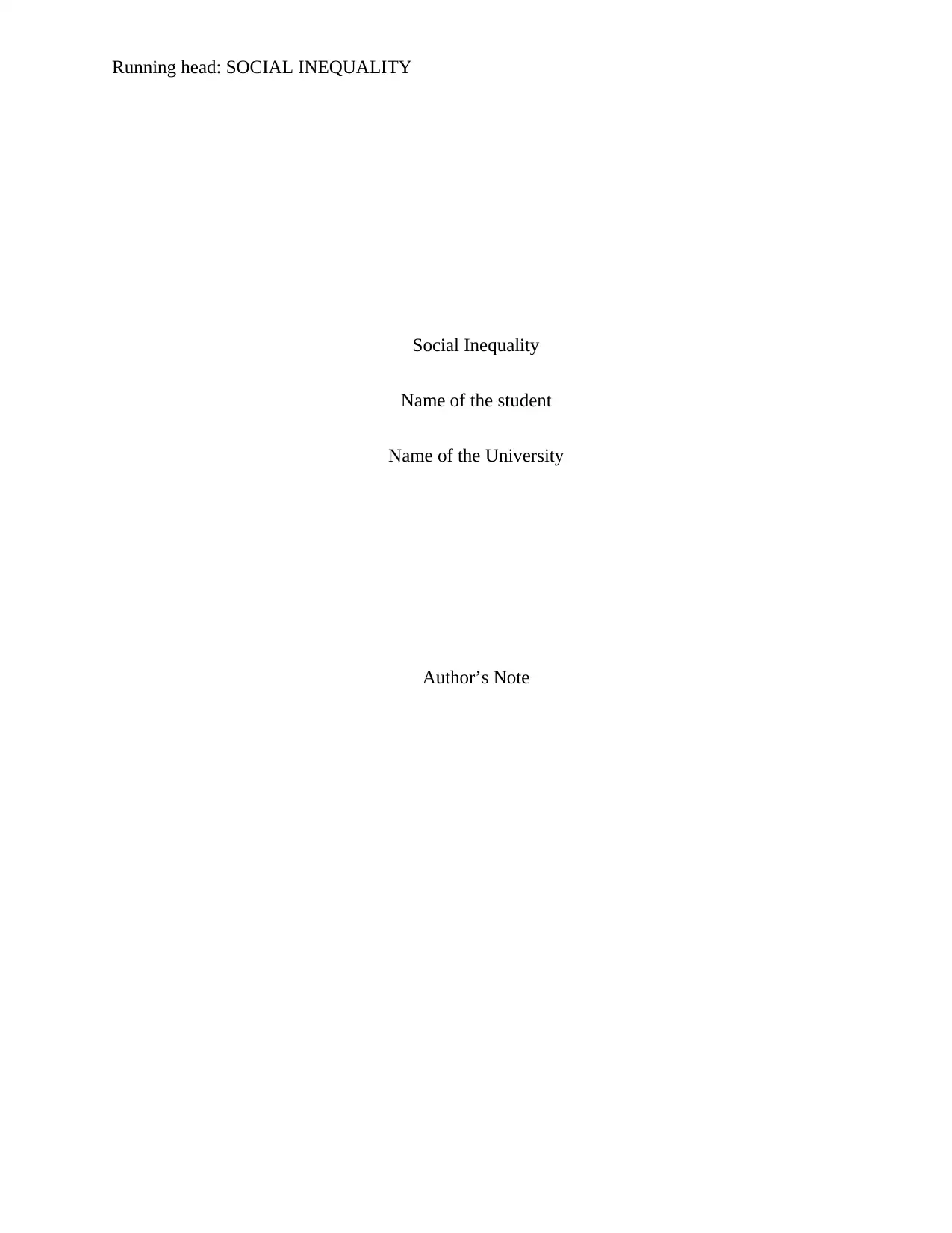
Running head: SOCIAL INEQUALITY
Social Inequality
Name of the student
Name of the University
Author’s Note
Social Inequality
Name of the student
Name of the University
Author’s Note
Paraphrase This Document
Need a fresh take? Get an instant paraphrase of this document with our AI Paraphraser
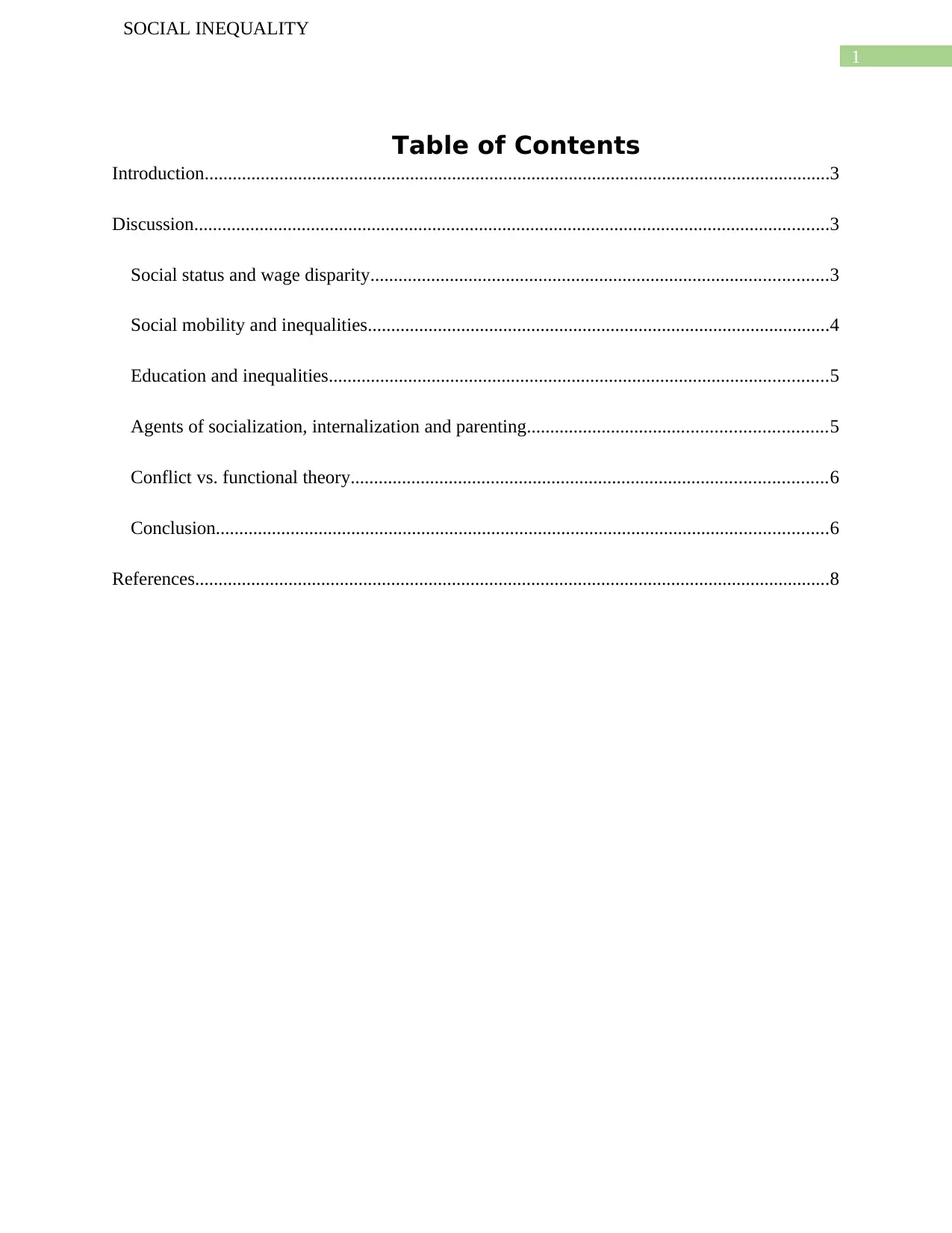
1
SOCIAL INEQUALITY
Table of Contents
Introduction......................................................................................................................................3
Discussion........................................................................................................................................3
Social status and wage disparity..................................................................................................3
Social mobility and inequalities...................................................................................................4
Education and inequalities...........................................................................................................5
Agents of socialization, internalization and parenting................................................................5
Conflict vs. functional theory......................................................................................................6
Conclusion...................................................................................................................................6
References........................................................................................................................................8
SOCIAL INEQUALITY
Table of Contents
Introduction......................................................................................................................................3
Discussion........................................................................................................................................3
Social status and wage disparity..................................................................................................3
Social mobility and inequalities...................................................................................................4
Education and inequalities...........................................................................................................5
Agents of socialization, internalization and parenting................................................................5
Conflict vs. functional theory......................................................................................................6
Conclusion...................................................................................................................................6
References........................................................................................................................................8
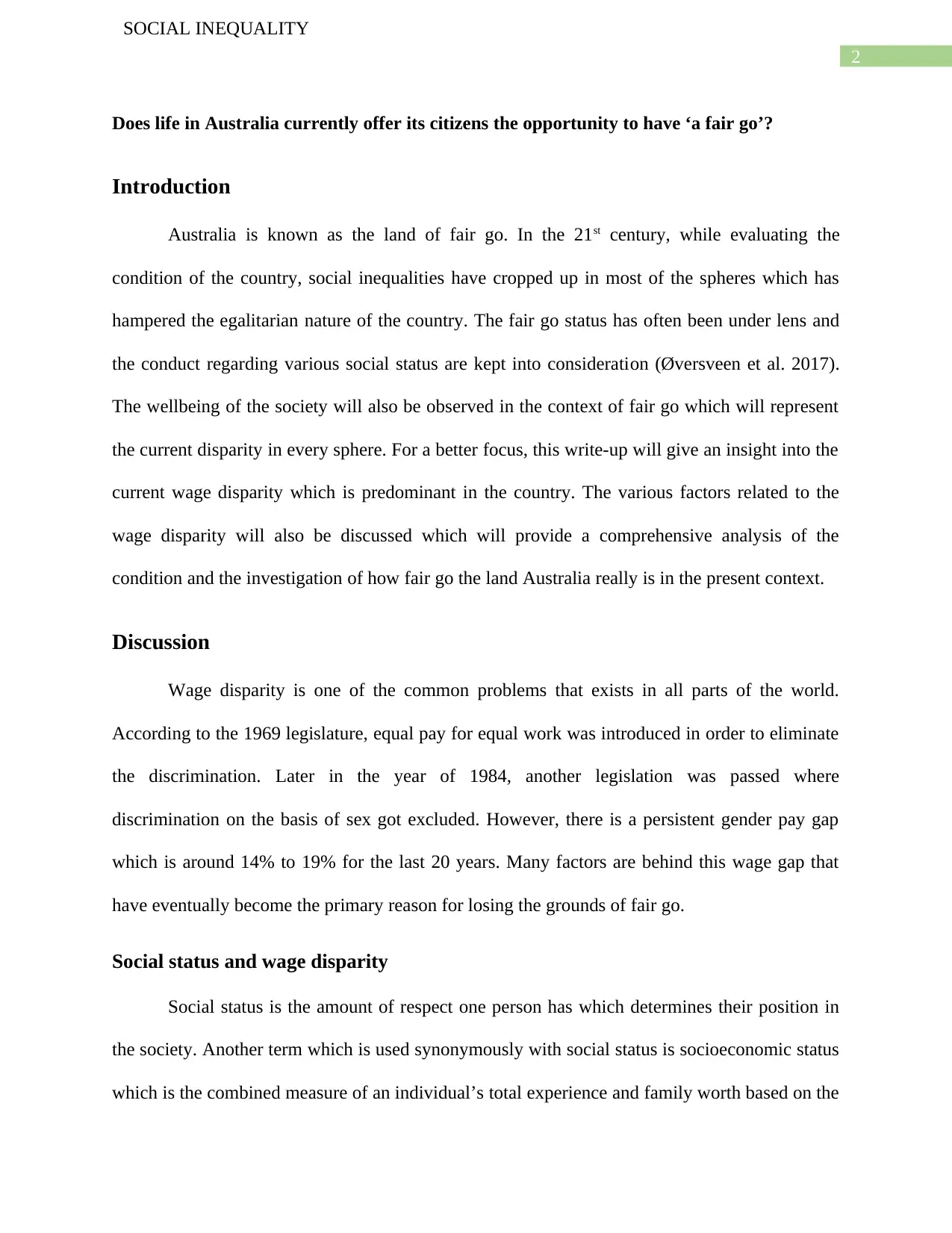
2
SOCIAL INEQUALITY
Does life in Australia currently offer its citizens the opportunity to have ‘a fair go’?
Introduction
Australia is known as the land of fair go. In the 21st century, while evaluating the
condition of the country, social inequalities have cropped up in most of the spheres which has
hampered the egalitarian nature of the country. The fair go status has often been under lens and
the conduct regarding various social status are kept into consideration (Øversveen et al. 2017).
The wellbeing of the society will also be observed in the context of fair go which will represent
the current disparity in every sphere. For a better focus, this write-up will give an insight into the
current wage disparity which is predominant in the country. The various factors related to the
wage disparity will also be discussed which will provide a comprehensive analysis of the
condition and the investigation of how fair go the land Australia really is in the present context.
Discussion
Wage disparity is one of the common problems that exists in all parts of the world.
According to the 1969 legislature, equal pay for equal work was introduced in order to eliminate
the discrimination. Later in the year of 1984, another legislation was passed where
discrimination on the basis of sex got excluded. However, there is a persistent gender pay gap
which is around 14% to 19% for the last 20 years. Many factors are behind this wage gap that
have eventually become the primary reason for losing the grounds of fair go.
Social status and wage disparity
Social status is the amount of respect one person has which determines their position in
the society. Another term which is used synonymously with social status is socioeconomic status
which is the combined measure of an individual’s total experience and family worth based on the
SOCIAL INEQUALITY
Does life in Australia currently offer its citizens the opportunity to have ‘a fair go’?
Introduction
Australia is known as the land of fair go. In the 21st century, while evaluating the
condition of the country, social inequalities have cropped up in most of the spheres which has
hampered the egalitarian nature of the country. The fair go status has often been under lens and
the conduct regarding various social status are kept into consideration (Øversveen et al. 2017).
The wellbeing of the society will also be observed in the context of fair go which will represent
the current disparity in every sphere. For a better focus, this write-up will give an insight into the
current wage disparity which is predominant in the country. The various factors related to the
wage disparity will also be discussed which will provide a comprehensive analysis of the
condition and the investigation of how fair go the land Australia really is in the present context.
Discussion
Wage disparity is one of the common problems that exists in all parts of the world.
According to the 1969 legislature, equal pay for equal work was introduced in order to eliminate
the discrimination. Later in the year of 1984, another legislation was passed where
discrimination on the basis of sex got excluded. However, there is a persistent gender pay gap
which is around 14% to 19% for the last 20 years. Many factors are behind this wage gap that
have eventually become the primary reason for losing the grounds of fair go.
Social status and wage disparity
Social status is the amount of respect one person has which determines their position in
the society. Another term which is used synonymously with social status is socioeconomic status
which is the combined measure of an individual’s total experience and family worth based on the
⊘ This is a preview!⊘
Do you want full access?
Subscribe today to unlock all pages.

Trusted by 1+ million students worldwide
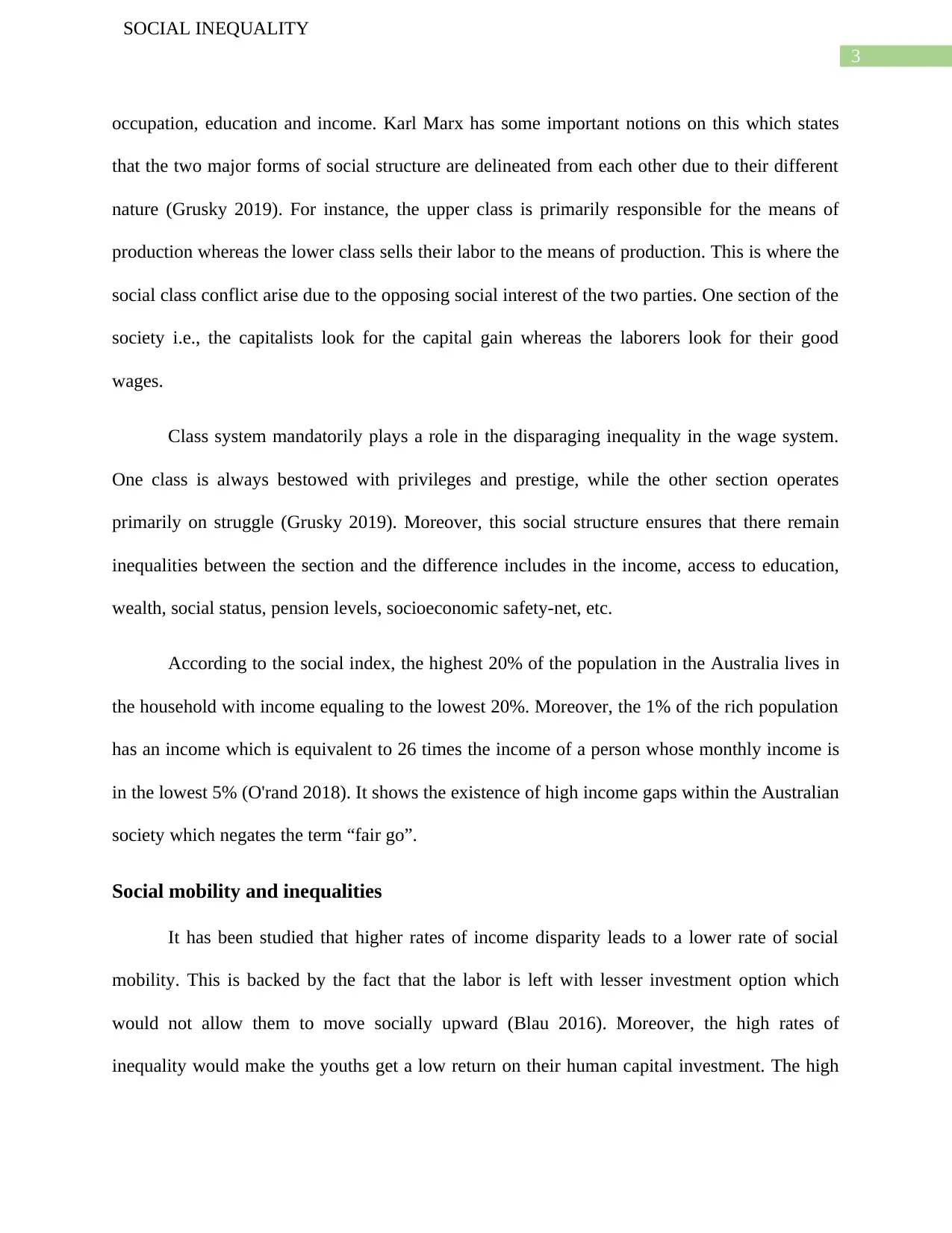
3
SOCIAL INEQUALITY
occupation, education and income. Karl Marx has some important notions on this which states
that the two major forms of social structure are delineated from each other due to their different
nature (Grusky 2019). For instance, the upper class is primarily responsible for the means of
production whereas the lower class sells their labor to the means of production. This is where the
social class conflict arise due to the opposing social interest of the two parties. One section of the
society i.e., the capitalists look for the capital gain whereas the laborers look for their good
wages.
Class system mandatorily plays a role in the disparaging inequality in the wage system.
One class is always bestowed with privileges and prestige, while the other section operates
primarily on struggle (Grusky 2019). Moreover, this social structure ensures that there remain
inequalities between the section and the difference includes in the income, access to education,
wealth, social status, pension levels, socioeconomic safety-net, etc.
According to the social index, the highest 20% of the population in the Australia lives in
the household with income equaling to the lowest 20%. Moreover, the 1% of the rich population
has an income which is equivalent to 26 times the income of a person whose monthly income is
in the lowest 5% (O'rand 2018). It shows the existence of high income gaps within the Australian
society which negates the term “fair go”.
Social mobility and inequalities
It has been studied that higher rates of income disparity leads to a lower rate of social
mobility. This is backed by the fact that the labor is left with lesser investment option which
would not allow them to move socially upward (Blau 2016). Moreover, the high rates of
inequality would make the youths get a low return on their human capital investment. The high
SOCIAL INEQUALITY
occupation, education and income. Karl Marx has some important notions on this which states
that the two major forms of social structure are delineated from each other due to their different
nature (Grusky 2019). For instance, the upper class is primarily responsible for the means of
production whereas the lower class sells their labor to the means of production. This is where the
social class conflict arise due to the opposing social interest of the two parties. One section of the
society i.e., the capitalists look for the capital gain whereas the laborers look for their good
wages.
Class system mandatorily plays a role in the disparaging inequality in the wage system.
One class is always bestowed with privileges and prestige, while the other section operates
primarily on struggle (Grusky 2019). Moreover, this social structure ensures that there remain
inequalities between the section and the difference includes in the income, access to education,
wealth, social status, pension levels, socioeconomic safety-net, etc.
According to the social index, the highest 20% of the population in the Australia lives in
the household with income equaling to the lowest 20%. Moreover, the 1% of the rich population
has an income which is equivalent to 26 times the income of a person whose monthly income is
in the lowest 5% (O'rand 2018). It shows the existence of high income gaps within the Australian
society which negates the term “fair go”.
Social mobility and inequalities
It has been studied that higher rates of income disparity leads to a lower rate of social
mobility. This is backed by the fact that the labor is left with lesser investment option which
would not allow them to move socially upward (Blau 2016). Moreover, the high rates of
inequality would make the youths get a low return on their human capital investment. The high
Paraphrase This Document
Need a fresh take? Get an instant paraphrase of this document with our AI Paraphraser
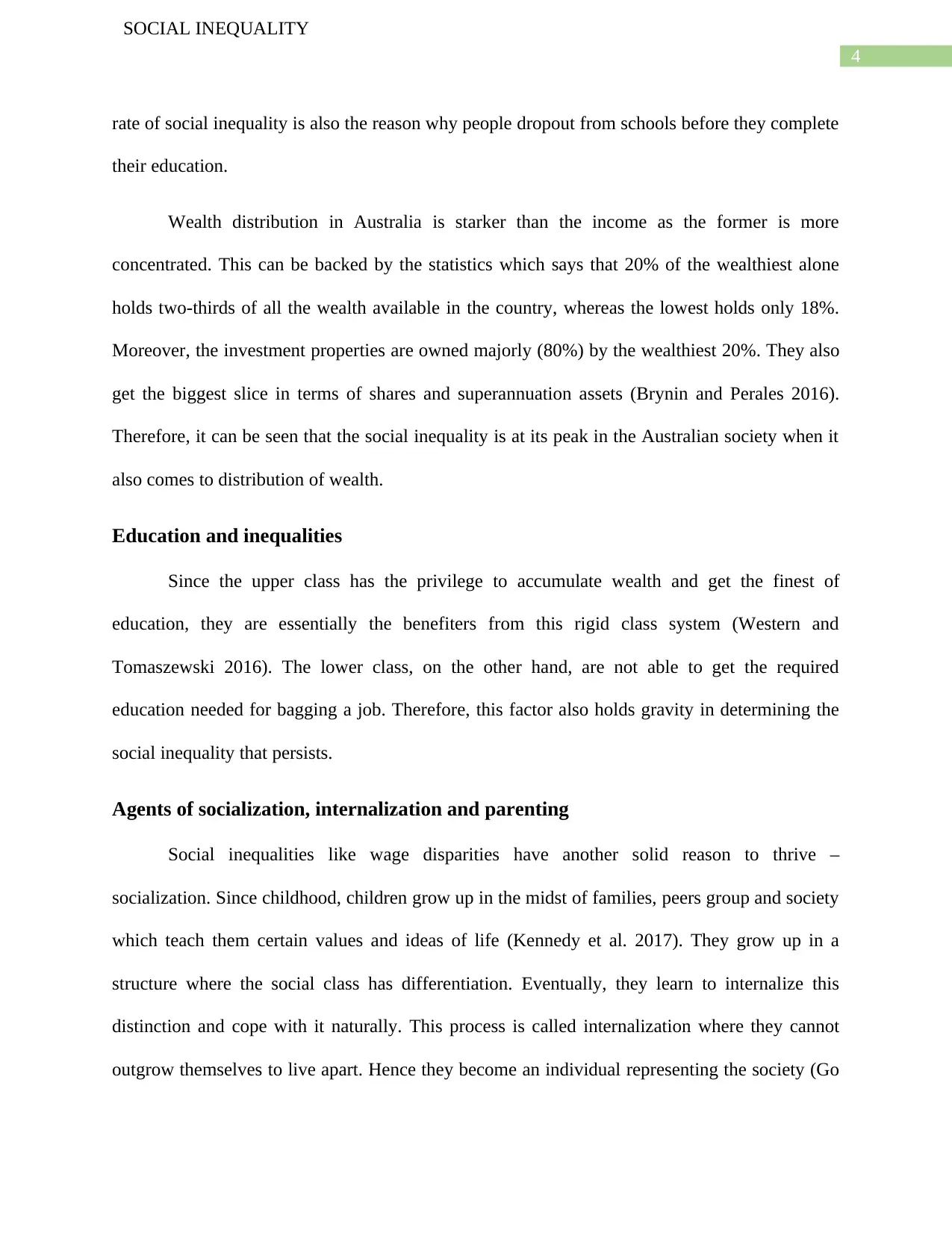
4
SOCIAL INEQUALITY
rate of social inequality is also the reason why people dropout from schools before they complete
their education.
Wealth distribution in Australia is starker than the income as the former is more
concentrated. This can be backed by the statistics which says that 20% of the wealthiest alone
holds two-thirds of all the wealth available in the country, whereas the lowest holds only 18%.
Moreover, the investment properties are owned majorly (80%) by the wealthiest 20%. They also
get the biggest slice in terms of shares and superannuation assets (Brynin and Perales 2016).
Therefore, it can be seen that the social inequality is at its peak in the Australian society when it
also comes to distribution of wealth.
Education and inequalities
Since the upper class has the privilege to accumulate wealth and get the finest of
education, they are essentially the benefiters from this rigid class system (Western and
Tomaszewski 2016). The lower class, on the other hand, are not able to get the required
education needed for bagging a job. Therefore, this factor also holds gravity in determining the
social inequality that persists.
Agents of socialization, internalization and parenting
Social inequalities like wage disparities have another solid reason to thrive –
socialization. Since childhood, children grow up in the midst of families, peers group and society
which teach them certain values and ideas of life (Kennedy et al. 2017). They grow up in a
structure where the social class has differentiation. Eventually, they learn to internalize this
distinction and cope with it naturally. This process is called internalization where they cannot
outgrow themselves to live apart. Hence they become an individual representing the society (Go
SOCIAL INEQUALITY
rate of social inequality is also the reason why people dropout from schools before they complete
their education.
Wealth distribution in Australia is starker than the income as the former is more
concentrated. This can be backed by the statistics which says that 20% of the wealthiest alone
holds two-thirds of all the wealth available in the country, whereas the lowest holds only 18%.
Moreover, the investment properties are owned majorly (80%) by the wealthiest 20%. They also
get the biggest slice in terms of shares and superannuation assets (Brynin and Perales 2016).
Therefore, it can be seen that the social inequality is at its peak in the Australian society when it
also comes to distribution of wealth.
Education and inequalities
Since the upper class has the privilege to accumulate wealth and get the finest of
education, they are essentially the benefiters from this rigid class system (Western and
Tomaszewski 2016). The lower class, on the other hand, are not able to get the required
education needed for bagging a job. Therefore, this factor also holds gravity in determining the
social inequality that persists.
Agents of socialization, internalization and parenting
Social inequalities like wage disparities have another solid reason to thrive –
socialization. Since childhood, children grow up in the midst of families, peers group and society
which teach them certain values and ideas of life (Kennedy et al. 2017). They grow up in a
structure where the social class has differentiation. Eventually, they learn to internalize this
distinction and cope with it naturally. This process is called internalization where they cannot
outgrow themselves to live apart. Hence they become an individual representing the society (Go
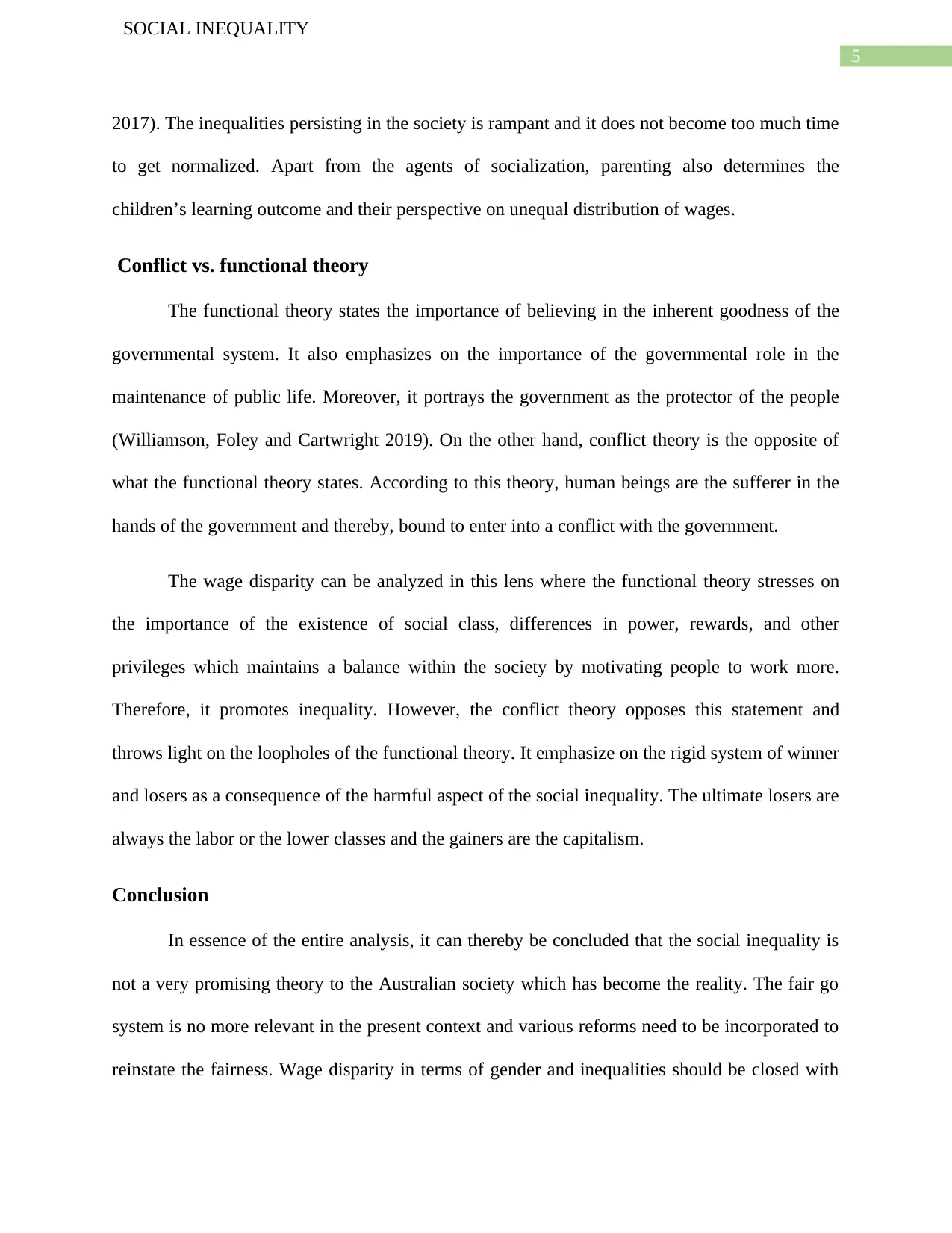
5
SOCIAL INEQUALITY
2017). The inequalities persisting in the society is rampant and it does not become too much time
to get normalized. Apart from the agents of socialization, parenting also determines the
children’s learning outcome and their perspective on unequal distribution of wages.
Conflict vs. functional theory
The functional theory states the importance of believing in the inherent goodness of the
governmental system. It also emphasizes on the importance of the governmental role in the
maintenance of public life. Moreover, it portrays the government as the protector of the people
(Williamson, Foley and Cartwright 2019). On the other hand, conflict theory is the opposite of
what the functional theory states. According to this theory, human beings are the sufferer in the
hands of the government and thereby, bound to enter into a conflict with the government.
The wage disparity can be analyzed in this lens where the functional theory stresses on
the importance of the existence of social class, differences in power, rewards, and other
privileges which maintains a balance within the society by motivating people to work more.
Therefore, it promotes inequality. However, the conflict theory opposes this statement and
throws light on the loopholes of the functional theory. It emphasize on the rigid system of winner
and losers as a consequence of the harmful aspect of the social inequality. The ultimate losers are
always the labor or the lower classes and the gainers are the capitalism.
Conclusion
In essence of the entire analysis, it can thereby be concluded that the social inequality is
not a very promising theory to the Australian society which has become the reality. The fair go
system is no more relevant in the present context and various reforms need to be incorporated to
reinstate the fairness. Wage disparity in terms of gender and inequalities should be closed with
SOCIAL INEQUALITY
2017). The inequalities persisting in the society is rampant and it does not become too much time
to get normalized. Apart from the agents of socialization, parenting also determines the
children’s learning outcome and their perspective on unequal distribution of wages.
Conflict vs. functional theory
The functional theory states the importance of believing in the inherent goodness of the
governmental system. It also emphasizes on the importance of the governmental role in the
maintenance of public life. Moreover, it portrays the government as the protector of the people
(Williamson, Foley and Cartwright 2019). On the other hand, conflict theory is the opposite of
what the functional theory states. According to this theory, human beings are the sufferer in the
hands of the government and thereby, bound to enter into a conflict with the government.
The wage disparity can be analyzed in this lens where the functional theory stresses on
the importance of the existence of social class, differences in power, rewards, and other
privileges which maintains a balance within the society by motivating people to work more.
Therefore, it promotes inequality. However, the conflict theory opposes this statement and
throws light on the loopholes of the functional theory. It emphasize on the rigid system of winner
and losers as a consequence of the harmful aspect of the social inequality. The ultimate losers are
always the labor or the lower classes and the gainers are the capitalism.
Conclusion
In essence of the entire analysis, it can thereby be concluded that the social inequality is
not a very promising theory to the Australian society which has become the reality. The fair go
system is no more relevant in the present context and various reforms need to be incorporated to
reinstate the fairness. Wage disparity in terms of gender and inequalities should be closed with
⊘ This is a preview!⊘
Do you want full access?
Subscribe today to unlock all pages.

Trusted by 1+ million students worldwide
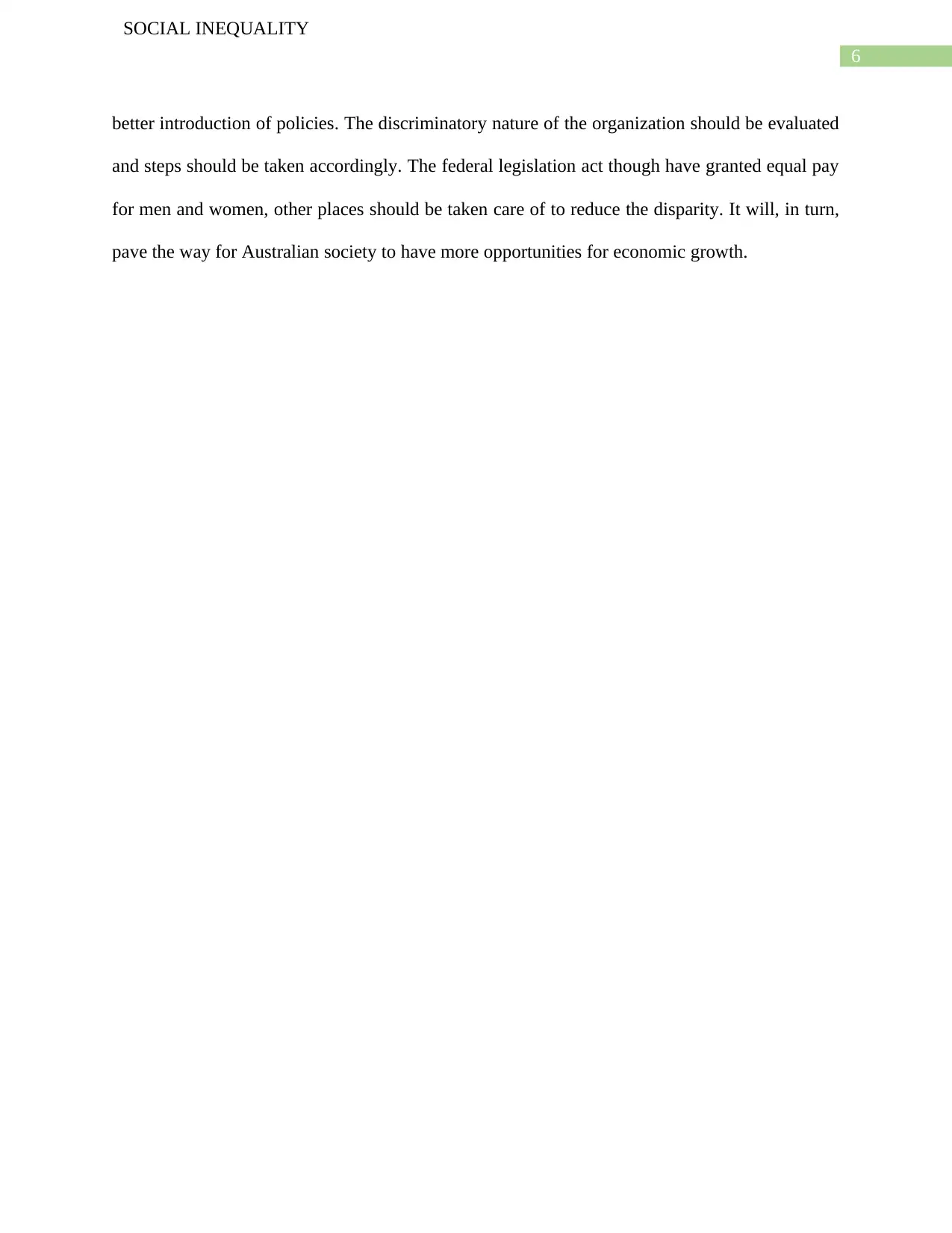
6
SOCIAL INEQUALITY
better introduction of policies. The discriminatory nature of the organization should be evaluated
and steps should be taken accordingly. The federal legislation act though have granted equal pay
for men and women, other places should be taken care of to reduce the disparity. It will, in turn,
pave the way for Australian society to have more opportunities for economic growth.
SOCIAL INEQUALITY
better introduction of policies. The discriminatory nature of the organization should be evaluated
and steps should be taken accordingly. The federal legislation act though have granted equal pay
for men and women, other places should be taken care of to reduce the disparity. It will, in turn,
pave the way for Australian society to have more opportunities for economic growth.
Paraphrase This Document
Need a fresh take? Get an instant paraphrase of this document with our AI Paraphraser

7
SOCIAL INEQUALITY
References
Blau, F.D., 2016. Gender, inequality, and wages. OUP Catalogue.
Brynin, M. and Perales, F., 2016. Gender wage inequality: The de-gendering of the occupational
structure. European Sociological Review, 32(1), pp.162-174.
Dixon, J. and Tran, N., 2017. A decomposition and microsimulation analysis of occupational
wage growth in Australia, 2010-2017. Centre of Policy Studies (CoPS), Victoria University.
(Dixon and Tran 2017)
Go, J., 2017. Decolonizing sociology: Epistemic inequality and sociological thought. Social
Problems, 64(2), pp.194-199.
Grusky, D., 2019. Social Stratification, Class, Race, and Gender in Sociological Perspective.
Routledge.
Kennedy, T., Rae, M., Sheridan, A. and Valadkhani, A., 2017. Reducing gender wage inequality
increases economic prosperity for all: Insights from Australia. Economic Analysis and
Policy, 55, pp.14-24.
O'rand, A., 2018. Age and inequality: Diverse pathways through later life. Routledge.
Øversveen, E., Rydland, H.T., Bambra, C. and Eikemo, T.A., 2017. Rethinking the relationship
between socio-economic status and health: Making the case for sociological theory in health
inequality research. Scandinavian journal of public health, 45(2), pp.103-112.
Western, M. and Tomaszewski, W., 2016. Subjective wellbeing, objective wellbeing and
inequality in Australia. PloS one, 11(10).
SOCIAL INEQUALITY
References
Blau, F.D., 2016. Gender, inequality, and wages. OUP Catalogue.
Brynin, M. and Perales, F., 2016. Gender wage inequality: The de-gendering of the occupational
structure. European Sociological Review, 32(1), pp.162-174.
Dixon, J. and Tran, N., 2017. A decomposition and microsimulation analysis of occupational
wage growth in Australia, 2010-2017. Centre of Policy Studies (CoPS), Victoria University.
(Dixon and Tran 2017)
Go, J., 2017. Decolonizing sociology: Epistemic inequality and sociological thought. Social
Problems, 64(2), pp.194-199.
Grusky, D., 2019. Social Stratification, Class, Race, and Gender in Sociological Perspective.
Routledge.
Kennedy, T., Rae, M., Sheridan, A. and Valadkhani, A., 2017. Reducing gender wage inequality
increases economic prosperity for all: Insights from Australia. Economic Analysis and
Policy, 55, pp.14-24.
O'rand, A., 2018. Age and inequality: Diverse pathways through later life. Routledge.
Øversveen, E., Rydland, H.T., Bambra, C. and Eikemo, T.A., 2017. Rethinking the relationship
between socio-economic status and health: Making the case for sociological theory in health
inequality research. Scandinavian journal of public health, 45(2), pp.103-112.
Western, M. and Tomaszewski, W., 2016. Subjective wellbeing, objective wellbeing and
inequality in Australia. PloS one, 11(10).
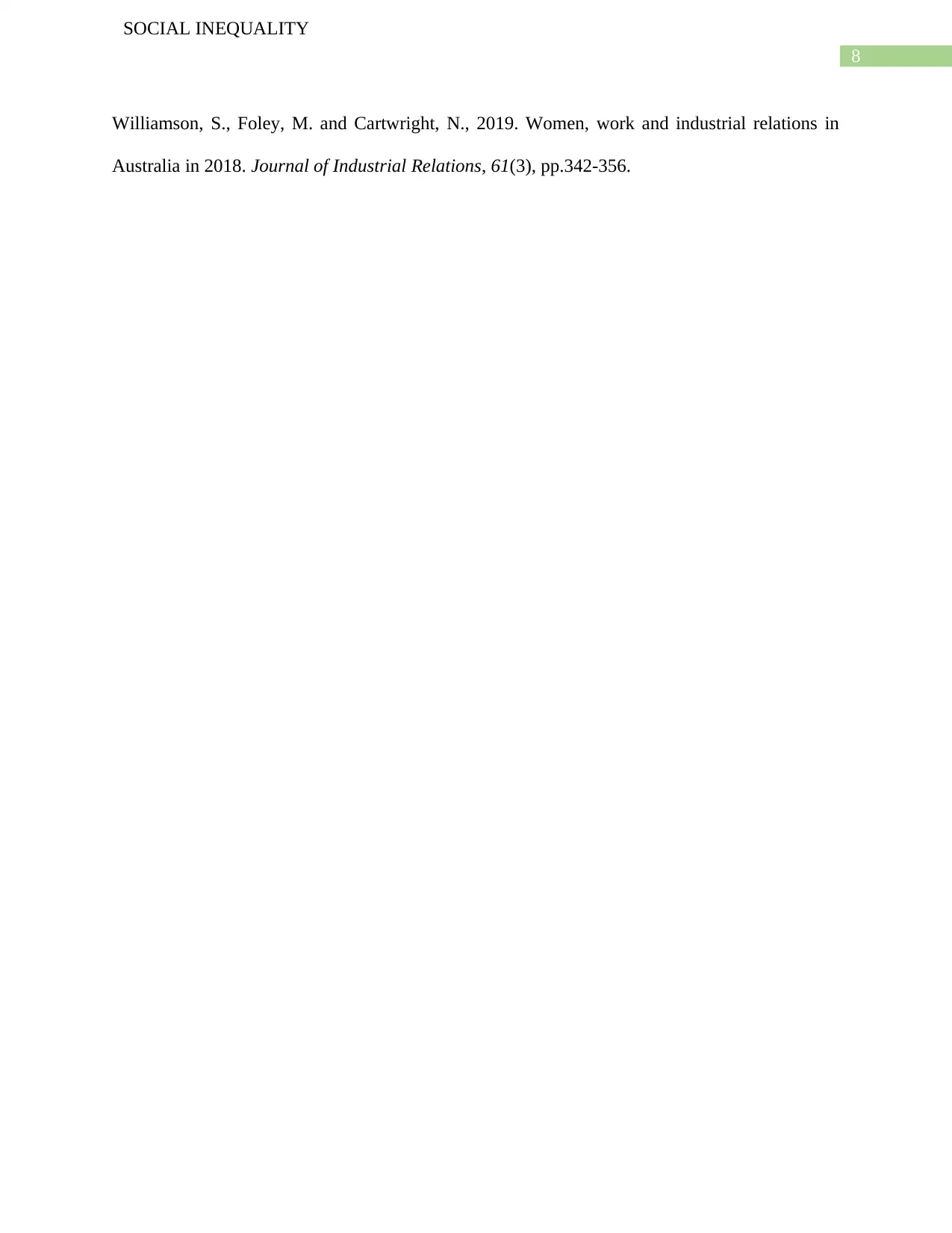
8
SOCIAL INEQUALITY
Williamson, S., Foley, M. and Cartwright, N., 2019. Women, work and industrial relations in
Australia in 2018. Journal of Industrial Relations, 61(3), pp.342-356.
SOCIAL INEQUALITY
Williamson, S., Foley, M. and Cartwright, N., 2019. Women, work and industrial relations in
Australia in 2018. Journal of Industrial Relations, 61(3), pp.342-356.
⊘ This is a preview!⊘
Do you want full access?
Subscribe today to unlock all pages.

Trusted by 1+ million students worldwide
1 out of 9
Related Documents
Your All-in-One AI-Powered Toolkit for Academic Success.
+13062052269
info@desklib.com
Available 24*7 on WhatsApp / Email
![[object Object]](/_next/static/media/star-bottom.7253800d.svg)
Unlock your academic potential
Copyright © 2020–2025 A2Z Services. All Rights Reserved. Developed and managed by ZUCOL.




